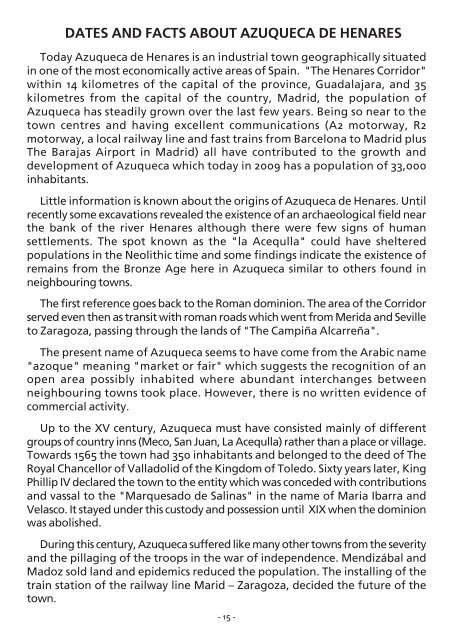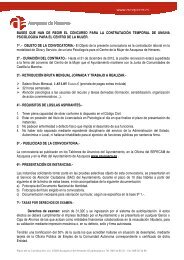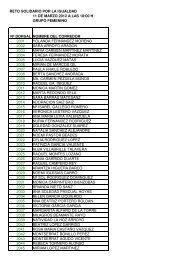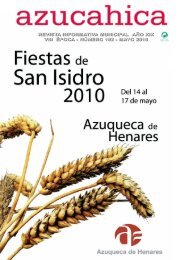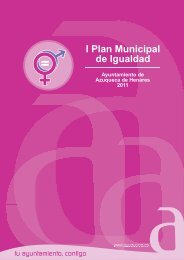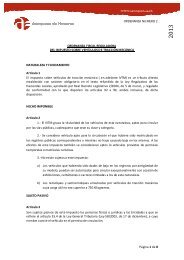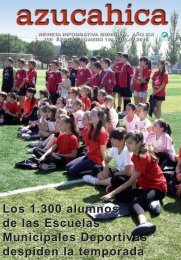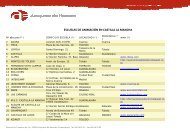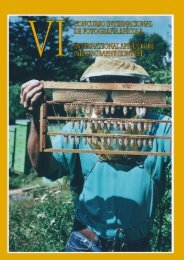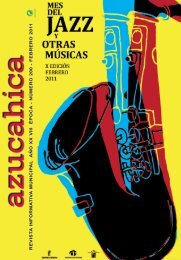VIII Concurso internacional de fotografía apícola, 2008, Catálogo
VIII Concurso internacional de fotografía apícola, 2008, Catálogo
VIII Concurso internacional de fotografía apícola, 2008, Catálogo
- No tags were found...
You also want an ePaper? Increase the reach of your titles
YUMPU automatically turns print PDFs into web optimized ePapers that Google loves.
DATES AND FACTS ABOUT AZUQUECA DE HENARESToday Azuqueca <strong>de</strong> Henares is an industrial town geographically situatedin one of the most economically active areas of Spain. "The Henares Corridor"within 14 kilometres of the capital of the province, Guadalajara, and 35kilometres from the capital of the country, Madrid, the population ofAzuqueca has steadily grown over the last few years. Being so near to thetown centres and having excellent communications (A2 motorway, R2motorway, a local railway line and fast trains from Barcelona to Madrid plusThe Barajas Airport in Madrid) all have contributed to the growth and<strong>de</strong>velopment of Azuqueca which today in 2009 has a population of 33,000inhabitants.Little information is known about the origins of Azuqueca <strong>de</strong> Henares. Untilrecently some excavations revealed the existence of an archaeological field nearthe bank of the river Henares although there were few signs of humansettlements. The spot known as the "la Acequlla" could have shelteredpopulations in the Neolithic time and some findings indicate the existence ofremains from the Bronze Age here in Azuqueca similar to others found inneighbouring towns.The first reference goes back to the Roman dominion. The area of the Corridorserved even then as transit with roman roads which went from Merida and Sevilleto Zaragoza, passing through the lands of "The Campiña Alcarreña".The present name of Azuqueca seems to have come from the Arabic name"azoque" meaning "market or fair" which suggests the recognition of anopen area possibly inhabited where abundant interchanges betweenneighbouring towns took place. However, there is no written evi<strong>de</strong>nce ofcommercial activity.Up to the XV century, Azuqueca must have consisted mainly of differentgroups of country inns (Meco, San Juan, La Acequlla) rather than a place or village.Towards 1565 the town had 350 inhabitants and belonged to the <strong>de</strong>ed of TheRoyal Chancellor of Valladolid of the Kingdom of Toledo. Sixty years later, KingPhillip IV <strong>de</strong>clared the town to the entity which was conce<strong>de</strong>d with contributionsand vassal to the "Marquesado <strong>de</strong> Salinas" in the name of Maria Ibarra andVelasco. It stayed un<strong>de</strong>r this custody and possession until XIX when the dominionwas abolished.During this century, Azuqueca suffered like many other towns from the severityand the pillaging of the troops in the war of in<strong>de</strong>pen<strong>de</strong>nce. Mendizábal andMadoz sold land and epi<strong>de</strong>mics reduced the population. The installing of thetrain station of the railway line Marid – Zaragoza, <strong>de</strong>ci<strong>de</strong>d the future of thetown.- 15 -


